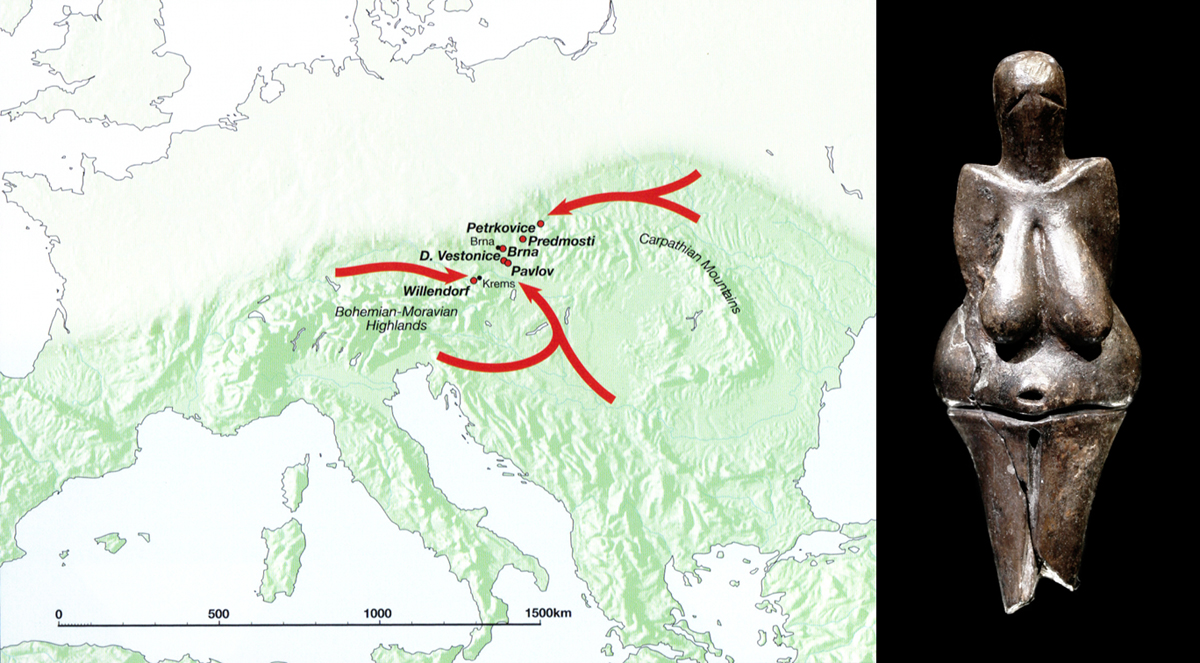


Dolní Věstonice
|
What and where is Dolní Věstonice?
Jill Cook, Keeper of Britain, Europe and Prehistory at the British Museum and Curator of the 2013 exhibition Ice Age art: arrival of the modern mind, sheds light on this in light of the archaeology as well as the Central and Eastern European Palaeolithic sculptures. She describes the significance of Dolní Věstonice in her publication Ice Age art: arrival of the modern mind:

Map of Central European sites - in Moravia these are concentrated in the valley that acted as a route through the adjacent mountains for animals and humans moving between the North European Plain and the Danube Basin. Image: Jill Cook. The Woman from Dolní Věstonice - a baked clay female figure which is the oldest known ceramic.
'After about 30,000 years ago, the undulating countryside within the natural corridor known as the Moravian Gate, connecting the North European Plain to the Danube Valley, became a significant area of human activity on a highway for migrating animals, notably mammoth herds.
The excavation of huge open-air campsites began in the late nineteenth century around Brno, Moravia, in the Czech Republic, revealing settlements constructed by communities of people who depended on mammoths for food and raw materials. Such settlements contain structures used as dwellings, as well as hearths, pits, thick spreads of ash from burnt bones and the remains of numerous mammoths sometimes stacked in piles sorted by anatomical parts.
Within these campsites stone and bone tools, decorated objects, ivory sculptures and the ceramic models are numerous. Several reports in the Illustrated London News between 1929 and 1937 headlined discoveries 'as wonderful as that of Tutankhamen', then heralded 'an amazing Palaeolithic Pompeii', 'the birth of sculpture' and the 'oldest human portrait'.
Although older sculptures have since been discovered, the rest of these populist headlines could still be applied to convey the richness and significance of the Moravian sites that produced many of the significant works described in this book. Of world renown is the baked clay female figure, the oldest known ceramic, from Dolní Věstonice, an enormous site at the southern end of the Moravian Gate'.
What and where is Dolní Věstonice? #sculpture #dwelling #ceramics https://t.co/OdssQi8Gxl #Archaeology #Palaeolithic #CzechRepublic pic.twitter.com/lJdwf1YKtQ
— Bradshaw Foundation (@BradshawFND) November 15, 2016
Artist rendition of a dwelling made of mammoth bones. Image: Dolní Věstonice Museum
The Upper Palaeolithic archaeological site of Dolní Věstonice is located in Moravia in the Czech Republic on the base of Děvín Mountain. Dating of the site is roughly 26,000 BP. The open-air site, located along a stream, has a particularly abundant source of prehistoric artefacts, in particular art, dating from the Gravettian period, which spanned roughly 27,000 to 20,000 B.C.
In her new book The First Signs: Unlocking the Mysteries of the World's Oldest Symbols, Genevieve von Petzinger vividly describes the scene of this Palaeolithic settlement, about one acre in size and encircled by a fence made of mammoth bones. Inside the fence, archaeologists have revealed a series of oval-shaped dwellings with hearths. From the dwellings, archaeologists estimate a population of one hundred people. The people of Dolní Věstonice were some of the first in Europe to begin burying their dead; burials with red ochre, stone tools, and personal adornments such as pierced marine shells, perforated teeth, and beads made from ivory. There is also a very unusual triple burial at Dolní Věstonice of three young adults - a female flanked by two males.
For these people, there is evidence of task specialization. People with individual skills were supported by others involved in subsistence activities. One such skill was ceramic production. A dedicated space with a kiln has been identified, where ceramics were produced - not for containers but for figurines. For the figurines, a durable result would have been sought, and analysis shows that the ceramic maker had discovered that by adding powdered bone to the clay, the figure would heat more evenly and not explode or crack in the process. This same combination created a self-glazing finish, as demonstrated by the Woman from Dolní Věstonice.
Ice Age Art - Arrival of the modern mind by Jill Cook:
http://www.bradshawfoundation.com/books/ice_age_art.php
The First Signs: Unlocking the Mysteries of the World's Oldest Symbols by Genevieve von Petzinger:
http://www.bradshawfoundation.com/news/rock_art.php?id=The-First-Signs
COMMENTS |
|











